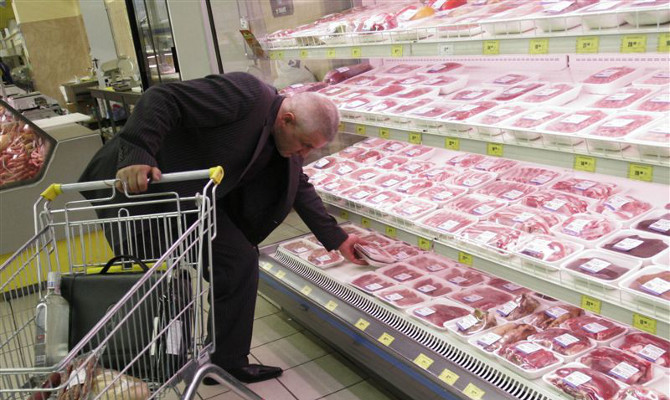Business
SituationDespite the world trend, the prices of food products in Ukraine will continue to rise

The FAO Food Price Index compiled by the UN Food and Agriculture Organization (FAO) reached its four-year lowest level in August, according to the FAO report published on the official website of the organization. The FAO Food Price Index averaged 196.6 points in August 2014. In August, the index registered its fifth consecutive monthly decline, down 7.3 points (3.6%) from July and 7.9 points (3.9%) from August 2013. The FAO Food Price Index is a measure of the monthly change in international prices of the basket of food commodities. It consists of the an average of five commodity group price indices, including cereal, vegetable oil, meat, milk and sugar.
Prices of all goods are falling
As the data of FAO experts show, the indices for all food categories, except for meat, dropped significantly in August. In particular, the cereal price index averaged 182.5 points, down 24.2 points (11.7%) from August 2013. Capital wrote that world grain prices have dropped to a four-year low. At that, the prices of rice remained on the rise reflecting the return of several traditional importers to the market and the failure of Thailand to offload large volumes from public stocks starting in August, as originally announced.
The FAO vegetable oil price index dropped in August by 15.2 points (8%) over August 2013 to 166.6 points, the lowest level since October 2009. “Much of the August decline reflects the pattern of palm oil prices, which have weakened under the combined effect of improved production prospects in Southeast Asia and lower than anticipated import demand, primarily from China and India,” reads the FAO report.
The average value of the sugar price index amounted to 244.3 points, 2.2 points (1%) higher than in August 2013. The drop in prices was triggered by improved production prospects of sugar cane and beet in India, EU and Russia. In addition, the reduction of import demand by China weighed negatively on the international prices. Meanwhile, downgrading of production in Brazil did not compensate for the declining prices.
Dairy products fell most with the index dropping by 46.8 points (18.9%) to 200.8 points. FAO experts believe that the decline was due to the abundance of supply and reduced import demand. Russia contributed to the situation by banning the import of dairy products in August. The decrease in purchases of whole milk powder by China, the largest importer, also contributed to the falling prices. Unlike other indices, the meat price index averaged 207.3 points in August, up 25 points (14%) over the last year. The increase principally reflected a strong rise of bovine meat prices in Australia, where herd rebuilding has reduced export supplies and the continued strong import demand in Asia, particularly China. The average quotations for poultry changed little, while those of pork and ovine meat dropped somewhat.
Ukraine is not following the trend
Declining food prices did not affect Ukraine. According to the State Statistics Service, the index of prices of food products in Ukraine grew 13.9% in August compared with August 2013.
For instance, the prices of bread increased 14.5% on average, pasta products – 14.3%, meat and meat products – 14.8%, fish – 22.7%, dairy products – 11.1%, cheese – 11.3%, vegetable oil – 13.5%. Prices for sugar increased most (54.2%), fruits – 41.7% and eggs – 20.6%
This is the impact of devaluation, explains Director of ProAgro Information Mykola Vernytskiy. “Food is becoming cheaper in dollars, while we buy for hryvnia. If you compare the decline in world prices, let’s say by the FAO index, by 3.6% and over 40% devaluation of the Ukrainian currency, we will have 36%, which should be somehow covered. There are also loans, which are difficult to service due to the same devaluation,” he adds.
Export oriented foods are an exception. For instance, the situation in the world greatly impacts the Ukrainian cereal market since Ukraine is one of the largest exporters and with huge yields orientation towards the global market is inevitable. “On the background of the decrease in world prices, domestic prices in Ukraine remained at the same level or even increased somewhat due to the rise in the dollar exchange rate,” says Head of the Analytical Department at AAA Consulting Company Maria Kolesnyk. The same applies to the segment of vegetable oils with Ukraine being the world’s leader.
The level of saturation of different segments contributes to the increase of prices in addition to devaluation, says General Director of Pro-Consulting Oleksandr Sokolov. “Prices are on the rise mainly in the segments experiencing shortages, when such shortages are covered by imported products,” he said.
What’s next?
Expert of agrarian markets at the Ukrainian Club of Agrarian Business Alina Zharko predicts that food prices in Ukraine will continue to escalate. “The prices of pork will increase by 3-4%, because due to fluctuations of the value of the hryvnia pork import amounted to only 1,100 t in August, dropping 4.4 times over eight months,” she added. Beef prices will rise by 2-2.5%.
One should not expect dairy prices to fall despite over-saturation of the market following Russia’s embargo, believes Kolesnyk. “Producers are not ready to lose the margin; they prefer to diversify production,” she emphasized. Only the prices of vegetables will continue to decline thanks to a banner harvest.






 of the agreement of syndication with Financial Times Limited are strictly prohibited. Use of materials which refers to France-Presse, Reuters, Interfax-Ukraine, Ukrainian News, UNIAN agencies is strictly prohibited. Materials marked
of the agreement of syndication with Financial Times Limited are strictly prohibited. Use of materials which refers to France-Presse, Reuters, Interfax-Ukraine, Ukrainian News, UNIAN agencies is strictly prohibited. Materials marked  are published as advertisements.
are published as advertisements.